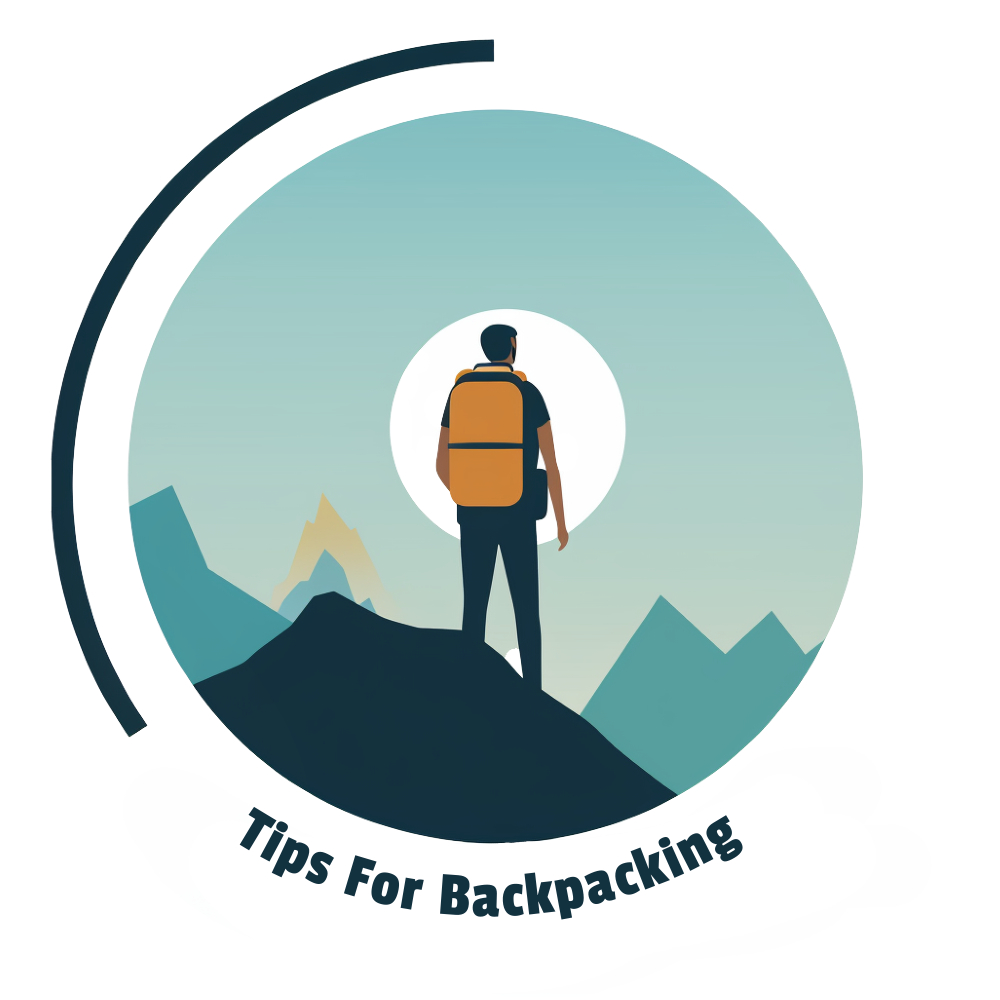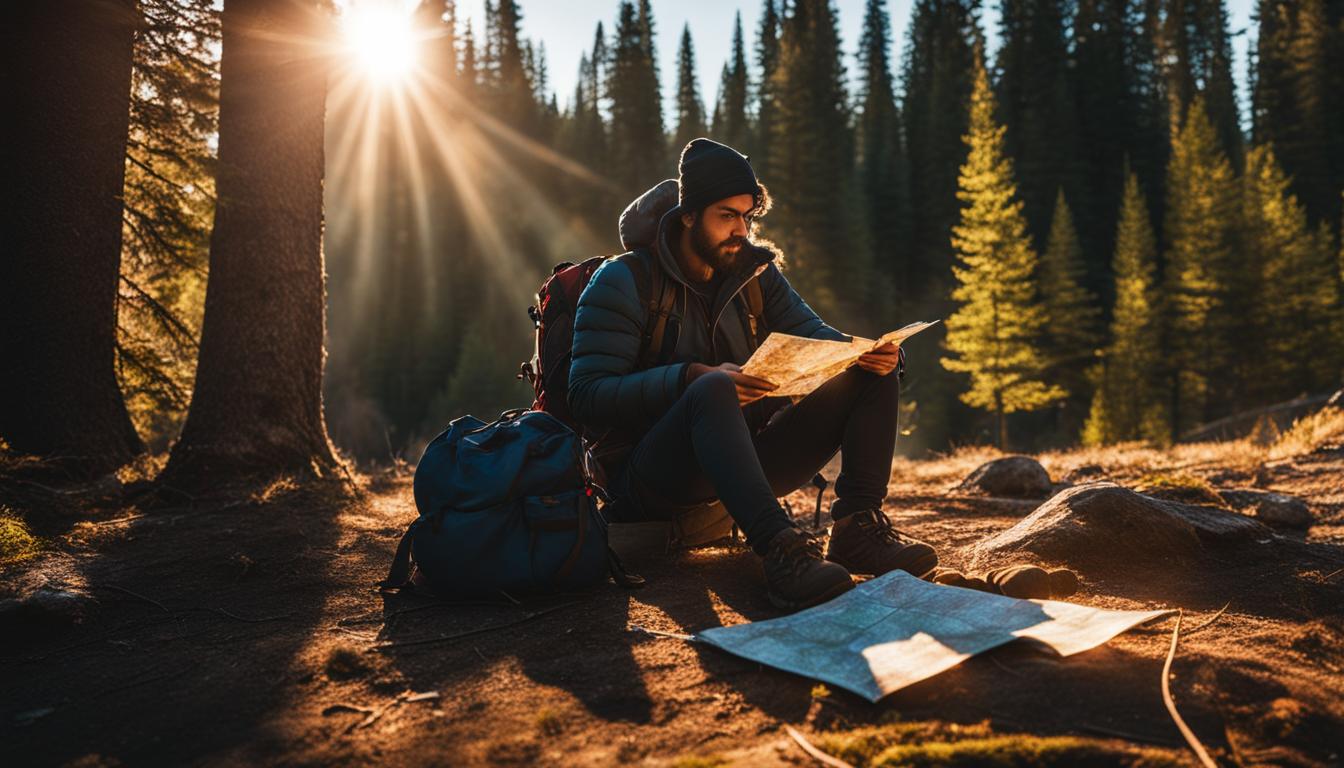Are you ready to embark on your first backpacking adventure? As a beginner, it’s important to have the right knowledge and preparation to make your trip successful. In this beginner’s guide to efficient backpacking, I’ll share with you some essential advice and top tips for first-time backpackers. So, let’s get started on how to prepare for backpacking as a beginner!
When venturing into the world of backpacking, it’s crucial to avoid common mistakes and learn from experienced backpackers. Packing light is key to an enjoyable trip, as it reduces strain on your body and allows for greater mobility on the trail. Remember, less is more!
Starting with shorter trips and gradually increasing difficulty will help build your skills and confidence. It’s also wise to learn basic navigational skills or team up with someone experienced in backpacking. Safety should always be a top priority, so familiarize yourself with safety guidelines and carry essential equipment.
Now that you have a glimpse of what lies ahead, let’s dive into more detailed tips and recommendations to make your first backpacking trip successful.
Key Takeaways:
- Pack light to reduce strain and move freely on the trail.
- Start with shorter trips and gradually increase difficulty to build skills and confidence.
- Learn basic navigational skills or go with someone experienced in backpacking.
- Ensure safety by familiarizing yourself with safety guidelines and carrying necessary equipment.
- Stay tuned for more tips and advice to make your backpacking journey unforgettable!
Choosing the Right Gear
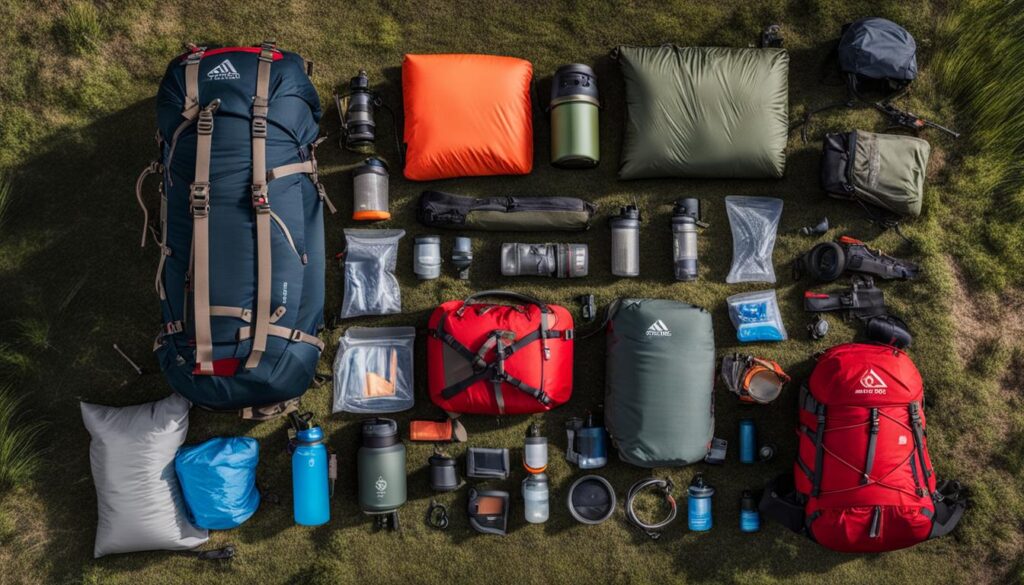
When it comes to backpacking, having the right gear can make or break your experience. As a beginner, it’s important to invest in the essential items that will ensure a successful trip. Here are some must-have equipment recommendations for beginner backpackers:
- Backpack: Look for a lightweight and durable backpack that fits your body comfortably. Consider the capacity based on the length of your trip and the amount of gear you’ll be carrying.
- Tent: Choose a tent that is lightweight and easy to set up. Look for one with good ventilation and weather resistance.
- Sleeping bag: Opt for a sleeping bag that is suitable for the climate you’ll be backpacking in. Look for one that is lightweight, compact, and has a temperature rating appropriate for the conditions.
- Cooking equipment: Invest in a lightweight stove, cookware, and a water filtration system for preparing meals and staying hydrated on the trail.
- Clothing: Pack moisture-wicking and quick-drying clothing that is suitable for layering. Don’t forget a waterproof jacket, warm hat, and gloves for unpredictable weather.
Before heading out on your backpacking trip, it’s important to test and become familiar with your gear. Set up your tent in your backyard, practice using your stove, and make sure your backpack fits comfortably with all your gear packed. Being prepared and knowledgeable about your equipment will ensure a smoother and more enjoyable backpacking experience.
“Having the right gear can make or break your backpacking experience.”
| Item | Recommendation |
|---|---|
| Backpack | Lightweight and durable backpack with proper fit |
| Tent | Lightweight and easy-to-set-up tent with good ventilation |
| Sleeping bag | Appropriate sleeping bag for the climate with a compact size |
| Cooking equipment | Stove, cookware, and water filtration system |
| Clothing | Moisture-wicking and quick-drying layers with waterproof jacket and accessories |
Remember, choosing the right gear is essential for a successful backpacking trip. Take the time to research and invest in quality equipment that will keep you comfortable and safe on the trail. With the right gear, you’ll be well-prepared to embark on your exciting backpacking adventure.
Planning Your Route and Trip
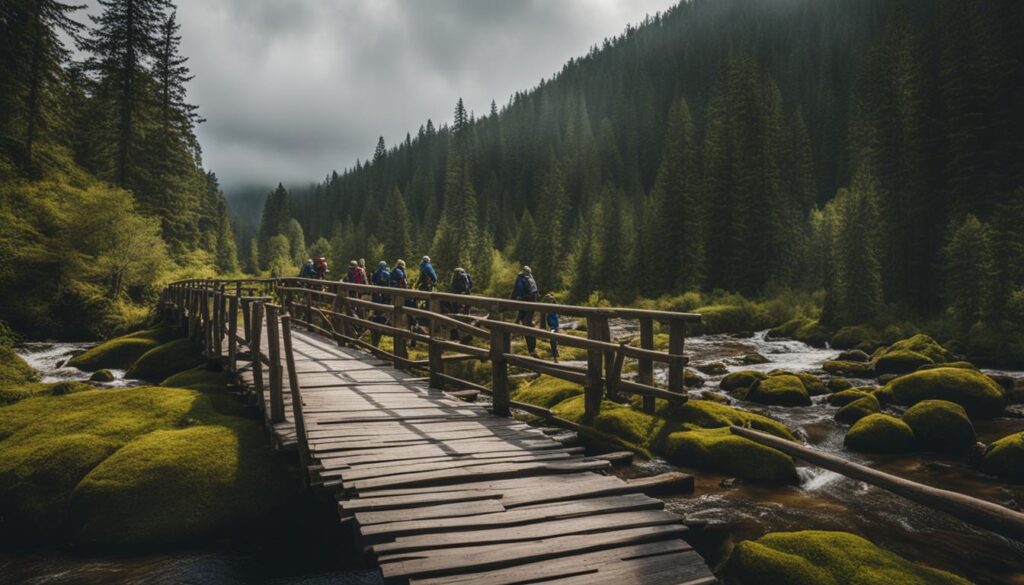
When embarking on a backpacking trip, careful planning is key to ensure a successful and enjoyable adventure. Here are some essential considerations to keep in mind when planning your route and trip:
Choosing the right route for beginners
As a beginner backpacker, it’s important to choose a route that matches your skill level and experience. Opt for trails with moderate difficulty and shorter distances to start. Research different backpacking destinations and consider factors such as elevation gain, trail conditions, and weather patterns. Look for trails that offer scenic views and access to essential amenities like water sources and campsites.
Tips for route planning
When planning your route, gather as much information as possible. Utilize hiking apps and websites that offer detailed trail maps and reviews from fellow backpackers. Consider joining online hiking communities or forums where you can seek advice and recommendations from experienced backpackers. Take note of any permits or passes required for your chosen destination and ensure you obtain them ahead of time.
Essential considerations for backpacking trip planning
In addition to selecting the right route, there are several other factors to consider when planning your backpacking trip. Estimate your daily mileage based on your fitness level and the difficulty of the trail. Plan your itinerary with realistic timeframes for each leg of the journey. Identify potential campsites along the route and research if they require reservations. Take into account water sources and plan where and how you will filter or treat water for drinking. Lastly, check the weather forecast and pack accordingly to ensure you are prepared for changing conditions.
By taking the time to carefully plan your route and trip, you can maximize your enjoyment and minimize the chances of encountering unexpected challenges along the way. Remember to always prioritize safety, be prepared, and embrace the adventure that awaits you in the great outdoors!
Safety Tips for Beginner Backpackers
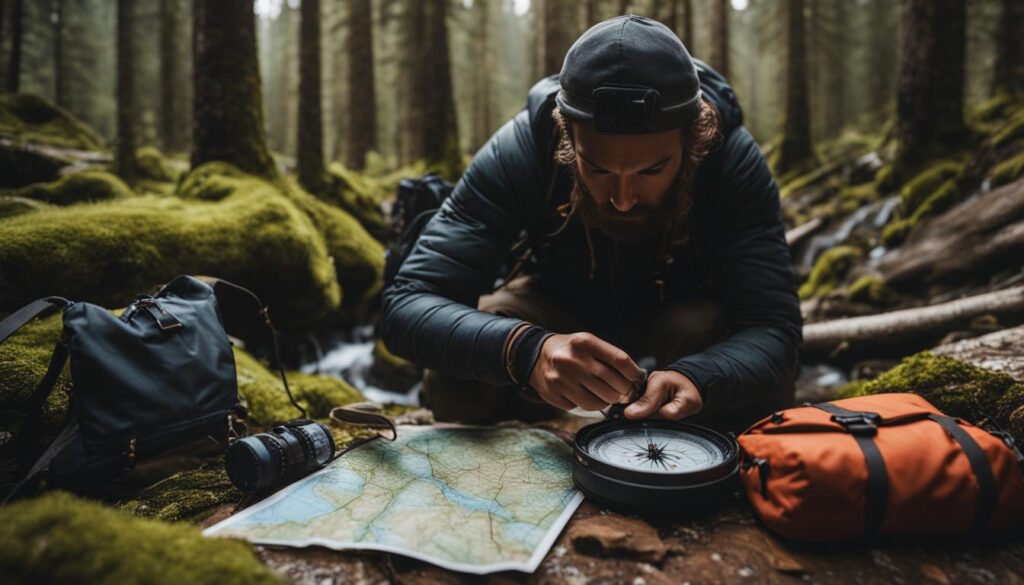
When heading out on a backpacking trip, safety should be a top priority. As a beginner backpacker, it’s essential to be aware of potential risks and take necessary precautions to stay safe in the wilderness. Here are some important safety considerations to keep in mind:
Plan and Prepare
Before embarking on your backpacking adventure, take the time to plan and prepare for various scenarios. Create a trip itinerary outlining your planned route, estimated hiking distances, and potential campsites. Share this itinerary with a trusted friend or family member who can check in on you if needed. Research the area you’ll be hiking in and familiarize yourself with potential hazards, such as wildlife encounters or tricky terrain. Being well-prepared will greatly enhance your safety on the trail.
Learn First Aid and Wilderness Survival Skills
Having basic first aid and wilderness survival skills can make a significant difference in emergency situations. Consider taking a first aid course that covers wilderness medicine to learn how to treat common injuries and illnesses that can occur while backpacking. Additionally, learning essential survival skills, like building a shelter or starting a fire, can help you stay safe and self-sufficient in unexpected circumstances. Remember, knowledge and preparedness are key to handling emergencies effectively.
Carry the Right Safety Equipment
Carrying essential safety equipment is crucial for any backpacking trip. Make sure to pack a well-stocked first aid kit that includes bandages, antiseptic ointment, pain relievers, and any necessary prescription medications. Additionally, always carry navigation tools, such as a map and compass (or GPS device), to help you stay on track. Other important safety items include a headlamp with extra batteries, a whistle to signal for help, and a lightweight emergency shelter, such as a bivy sack or emergency blanket. Being prepared with the right equipment can make a significant difference in a crisis.
“Safety must always be the guiding principle while backpacking. It’s better to be over-prepared than under-prepared. Take the time to plan, learn important skills, and carry the right safety equipment. Ultimately, your safety is in your hands.”
Remember, safety is paramount when embarking on a backpacking trip. By planning and preparing adequately, acquiring essential skills, and carrying the right equipment, you’ll be better equipped to handle any challenges that may arise. Stay safe, enjoy the adventure, and make unforgettable memories in the great outdoors.
Wilderness Etiquette and Leave No Trace Principles
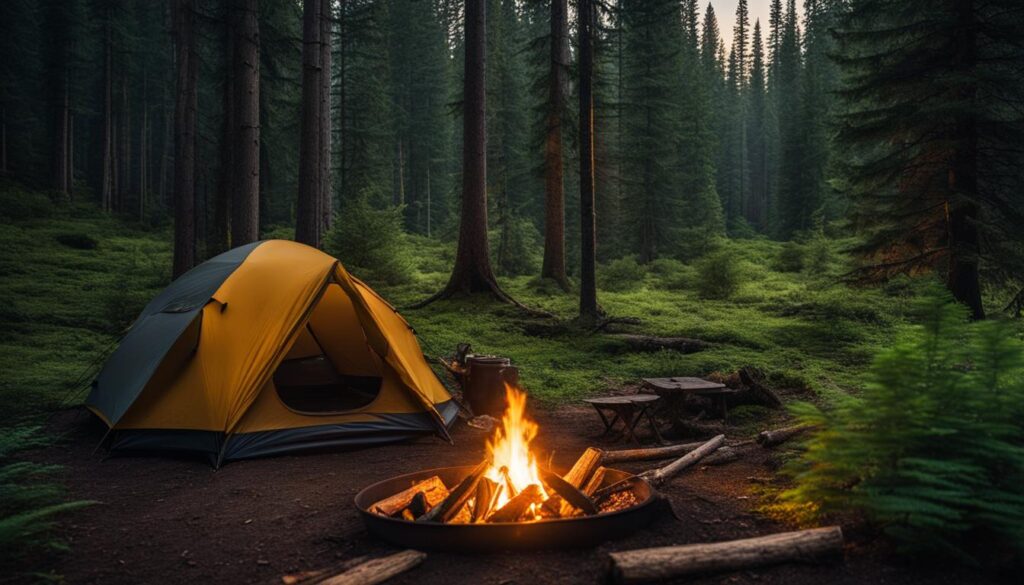
When backpacking in the great outdoors, it is essential to prioritize responsible outdoor practices and minimize our environmental impact. By following Leave No Trace principles and practicing backpacking etiquette, we can ensure the preservation of our natural spaces for future generations to enjoy.
Leave No Trace Principles
The Leave No Trace principles are a set of guidelines that promote sustainable outdoor recreation. These principles include:
- Plan ahead and prepare: Properly research your route, pack the right gear, and have a solid understanding of the wilderness area you will be exploring.
- Travel and camp on durable surfaces: Stick to established trails and camp in designated areas to minimize damage to vegetation and soil.
- Dispose of waste properly: Pack out all trash, including food scraps and toilet paper. When nature calls, use a trowel to dig a 6 to 8-inch hole at least 200 feet away from water sources and campsites.
- Leave what you find: Resist the temptation to take souvenirs from the wilderness. Leave rocks, plants, and historical artifacts untouched for others to enjoy.
- Minimize campfire impacts: Follow all fire regulations and guidelines. Use established fire rings when available and only burn small, dead wood. Remember to fully extinguish the fire before leaving the area.
- Respect wildlife: Observe wildlife from a distance and never feed them. Keep food and scented items securely stored to prevent attracting wildlife to your campsite.
- Be considerate of other visitors: Keep noise levels low, yield to other hikers, and respect the solitude and serenity of the wilderness.
Backpacking Etiquette
Aside from the Leave No Trace principles, there are additional etiquette guidelines that backpackers should follow:
- Yield to uphill hikers: If you encounter someone hiking uphill while you are descending, step aside and let them pass. Uphill hikers require more effort and should be given the right of way.
- Keep a safe distance: When encountering other hikers or wildlife, give them plenty of space. This ensures the safety of both parties and minimizes unnecessary disturbances.
- Practice noise discipline: Avoid loud conversations and excessive noise that can disrupt the natural environment and disturb wildlife and other hikers.
- Respect camping areas: If you come across a campsite that is already occupied, find another suitable spot to set up your tent. All hikers deserve their privacy and tranquility in the wilderness.
By adhering to these principles and guidelines, we can all play a role in protecting and preserving the pristine beauty of our natural landscapes. Let’s be responsible stewards of the outdoors and leave nothing but footprints behind.
Building Fitness and Endurance for Backpacking
When it comes to backpacking, being physically fit and having endurance are essential for a successful trip. The great outdoors can be challenging, with rugged terrains and long miles to cover, so it’s important to prepare your body for the adventure ahead. Here are some fitness tips for backpacking to help you build the strength and endurance needed for outdoor adventures.
Training for Backpacking Trips
To prepare for backpacking trips, it’s important to incorporate both cardiovascular and strength training exercises into your fitness routine. Cardiovascular exercises, such as running, biking, or hiking, will help improve your endurance and stamina. Aim to gradually increase your distance and intensity over time, simulating the conditions of a backpacking trip. Strength training exercises, such as squats, lunges, and core exercises, will help build the muscle strength needed to carry a heavy backpack and navigate challenging terrains.
Building Endurance for Outdoor Adventures
Building endurance is crucial for backpacking trips, as you’ll be spending long hours on your feet, carrying a heavy pack. Incorporate long hikes into your training regimen, gradually increasing the distance and elevation gain. This will not only improve your cardiovascular endurance but also allow your body to acclimate to the demands of backpacking. Additionally, consider incorporating interval training into your routine, alternating between bursts of high-intensity exercises and periods of rest. This will help simulate the unpredictable and varied nature of backpacking trails.
Physical Preparation for Beginner Backpackers
If you’re new to backpacking or haven’t engaged in regular physical activity, it’s important to start slowly and gradually increase your fitness level. Begin with shorter hikes and less challenging terrains, allowing your body to adjust to the physical demands of backpacking. As you feel more comfortable, gradually increase the difficulty level and distance of your hikes. Remember to listen to your body and give yourself time to rest and recover between training sessions. Your fitness and endurance will improve over time with consistent effort and dedication.
| Exercise | Frequency | Duration |
|---|---|---|
| Hiking | 3 times a week | 1-2 hours |
| Running | 2-3 times a week | 30-45 minutes |
| Strength Training | 2-3 times a week | 30-60 minutes |
| Interval Training | 1-2 times a week | 20-30 minutes |
Conclusion
Final Thoughts on Beginner Backpacking
As we come to the end of this article, I hope you feel more confident and excited about embarking on your first backpacking adventure. Remember, preparation is key to a successful trip. By following the essential tips we’ve discussed, you’ll be well-equipped to tackle the challenges that come with backpacking.
In summary, ensure you pack light and choose the right gear for your trip. Take the time to plan your route and familiarize yourself with the trail. Prioritize safety by sharing your itinerary, learning basic first aid, and carrying necessary safety equipment. Practice wilderness etiquette and leave no trace principles to preserve the beauty of nature. And finally, build your fitness and endurance to fully enjoy the journey.
So go ahead, take that first step into the world of backpacking. Embrace the freedom, the adventure, and the connection with nature. Whether you’re exploring local trails or venturing into the backcountry, backpacking will surely leave you with unforgettable memories and a newfound love for the great outdoors. Happy hiking!
FAQ
What are some common mistakes to avoid as a beginner backpacker?
Some common mistakes to avoid include overpacking, not testing your gear before a trip, and not being prepared for unexpected weather conditions.
How important is it to pack light for a backpacking trip?
Packing light is crucial for a successful backpacking trip as it allows for easier and more comfortable hiking, reduces strain on your body, and increases your overall enjoyment of the experience.
How can I reduce the weight of my backpack?
You can reduce the weight of your backpack by selecting lightweight gear, packing only essential items, and minimizing unnecessary items such as multiple changes of clothing.
Should I start with shorter backpacking trips as a beginner?
Yes, it is recommended to start with shorter trips to build experience and confidence before taking on longer and more challenging routes.
How important is it to learn navigational skills for backpacking?
Learning navigational skills is crucial for backpacking to ensure you can find your way and stay safe on the trail. It is recommended to practice using maps, compasses, and navigation apps before heading out.
Is it necessary to go with someone who has backpacking experience?
It is highly encouraged to go with someone who has backpacking experience, especially as a beginner. They can provide guidance, support, and help ensure your safety on the trail.
What gear do I need for a backpacking trip?
Essential gear for a backpacking trip includes a backpack, tent, sleeping bag, cooking equipment, and proper clothing. It is important to choose lightweight and durable options suitable for beginners.
How can I become familiar with my gear before a trip?
To become familiar with your gear, it is recommended to set up your tent, practice using your stove, and test your sleeping bag and other equipment in a controlled environment before heading out on a trip.
How should I plan my backpacking trip?
Planning your backpacking trip involves choosing a suitable route, estimating daily mileage, considering elevation gain, and identifying potential campsites and water sources. Utilize hiking apps, topographical maps, and online resources for route planning.
What safety considerations should I keep in mind as a beginner backpacker?
Important safety considerations include preparing a trip itinerary and sharing it with someone, knowing basic first aid and wilderness survival skills, and carrying necessary safety equipment such as a first aid kit and navigation tools.
How important is it to practice Leave No Trace principles while backpacking?
Practicing Leave No Trace principles is essential to minimize your impact on the environment. This includes packing out trash, disposing of waste properly, respecting wildlife and vegetation, and minimizing campfire impact.
How can I build fitness and endurance for backpacking trips?
Building fitness and endurance involves regular exercise, including hiking and strength training. Gradually increase physical activity and challenge yourself to prepare for the demands of a backpacking trip.
